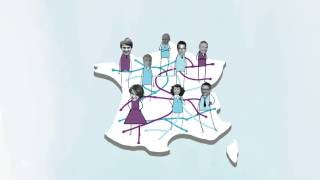Our history: a common destiny sustained by shared roots
At the end of a business combination process first launched in 2006, the Banque Populaire and Caisse d’Epargne retail banking networks merged their central institutions on July 31, 2009 leading to the creation of Groupe BPCE, the second largest banking group in France.
To watch this YouTube video, you must accept cookies from the Social Networks category, which includes YouTube, by clicking here.

An alliance between unique and complementary brands
Our two retail banking networks have long shared similar origins, deeply rooted in the heart of the French regions.
As they already share the same cooperative business model, their combination within Groupe BPCE further enhances their active commitment to local and regional development.
1818 Birth of the first Caisse d’Epargne, set up to promote, collect, and manage general public savings
1878 Creation of the first Banque Populaire bank, founded by and for entrepreneurs
For further details:
Key players in the history of banking
Partners of their customers in their day-to-day activities and at every major stage in their lives, the banks belonging to Groupe BPCE have always played a key role in the unfolding transformation of the banking, social, industrial and digital dimensions of our society.
Discover our web series – One brand, one history – that presents some of the more significant events in the lives of seven of our banking institutions!
To watch this YouTube video, you must accept cookies from the Social Networks category, which includes YouTube, by clicking here.

Episode 1 – Banque Populaire… after the end of the First World War
The story begins like this…
It was 1917, in the throes of the First World War. Battles were still being waged around the world but the end of the conflict was in sight. And people in France were already thinking about what would happen after the war had ended. What could be done? How could the millions of soldiers be helped to pick up their old lives and return to their jobs after spending so long in the front lines?
To watch this YouTube video, you must accept cookies from the Social Networks category, which includes YouTube, by clicking here.

Episode 2 – Caisse d’Epargne… and the history of the Livret A passbook savings account
Sunday, November 15, 1818, 9 o’clock a.m.: the Paris Caisse d’Epargne savings bank opened its doors to the public for the very first time. Louise, a young 10-year-old girl, could scarcely hide her excitement. Her aunt, a washerwoman working in Place Maubert, had opened a passbook savings account for her at the Caisse d’Epargne. In her very own name! It was completely unheard of! Everybody could have one, even women and children… even her!
To watch this YouTube video, you must accept cookies from the Social Networks category, which includes YouTube, by clicking here.

Episode 3 – Crédit Foncier… or the history of real-estate finance
March 28, 1852, the first building society named Banque foncière de Paris was created. Mathieu, a young farmer, applied for a loan from Crédit Foncier to finance his project… indeed, just like the Emperor’s own family! At the same time, Crédit Foncier became the No.1 lender to local authorities. In this capacity, it contributed to the transformation of Paris led by Baron Haussmann…
To watch this YouTube video, you must accept cookies from the Social Networks category, which includes YouTube, by clicking here.

Episode 4 – Natixis Interépargne and employee savings schemes
In May 1968, France was paralyzed and the French were marching in the streets. To resolve the crisis, General de Gaulle counted on his plan to offer workers a share in the profits generated by their companies. Give them a financial reward for their involvement: a system he had introduced by decree one year earlier. Daniel, 18, thought it was a good idea…
To watch this YouTube video, you must accept cookies from the Social Networks category, which includes YouTube, by clicking here.

Episode 5 – Crédit Coopératif… a distinct yet fully-fledged banking institution
1893. Banque coopérative des associations ouvrières de production (the ‘Cooperative Bank of Workers’ Production Associations’ or BCAOP) came into being. A fantastic opportunity for Faustin, the head of a building production cooperative known as La Fourmi (‘The Ant’) because the other banks had refused to give him a loan. On the eve of the Second World War, La Fourmi wanted to modernize. Marcel, its senior manager at that time, went to see the Caisse Centrale de Crédit Coopératif, known as the 4Cs…
To watch this YouTube video, you must accept cookies from the Social Networks category, which includes YouTube, by clicking here.

Episode 6 – Banque Palatine… know-how at the service of intermediate-sized enterprises
The first Maison Vernes was founded 1780 but it wasn’t until the 19th century that the bank really came into its own. In 1830, Louis, an entrepreneur who had founded his metallurgical company during the Bourbon Restoration, became a customer of Banque Vernes in Paris. Friends had recommended this merchant banking institution specializing in financial operations and wealth management solutions…
To watch this YouTube video, you must accept cookies from the Social Networks category, which includes YouTube, by clicking here.

Episode 7 – CASDEN Banque Populaire… a bank in a category of its own
In the early 1950s, banks didn’t offer many loans to private individuals, and interest rates were high! To address this gap in the market, members of the teaching profession came up with the idea of pooling their savings in order to lend money to one other. The Caisse de Prêts de l’Education Nationale de Seine-et-Oise (the loan fund of the French National Education system in the Seine-et-Oise département) was born. At the end of 1951, it already boasted 551 members…